From the twang of the theme song, the images of rural Wisconsin landscapes, and the accents that seemed straight from the set of Fargo, Netflix’s documentary series “Making a Murderer” seemed all too familiar. I’ve been living, reading, and writing in the Midwest since birth. “Making a Murderer” tapped into my deeply felt Midwestern sense of place.
The series follows the trials and convictions of Steven Avery – first, for the sexual assault of Penny Beerntsen in 1985, a crime for which he served 18 years in prison only to be exonerated by DNA evidence and the legal efforts of the Wisconsin Innocence Project. Then, for the murder of Teresa Halbach a mere two years after his release and amid a lawsuit against the Manitowoc County Police who had originally put him behind bars.
Like This American Life’s spinoff podcast, “Serial” and HBO’s documentary series, “The Jinx,” “Making a Murderer” repackages deeply compelling violent crimes as deeply compelling narrative. Where “Making a Murderer” departs from its flashier counterparts is its deep entrenchment in place.
The absence of mediating narrator – both Sarah Koenig (“Serial”) and Andrew Jarecki (“The Jinx”) play central roles in their narrative investigations – as well as the reliance on amateur footage, courtroom tape, and aerial shots of the Averys’ property functions much more mimetically than the medium of other true crime narratives. In its rootedness in the particulars of Manitowoc, Wisconsin, “Making a Murderer“‘s sense of place invokes a much older genre: American literary regionalism.
In ways that echo regionalist novels like Sarah Orne Jewett’s “The Country of Pointed Firs” or Edith Wharton’s “Ethan Frome,” directors Moira Demos and Laura Ricciardi meticulously record the particulars of Manitowoc County. Viewers experience the local politics, social structures, and class distinctions that initially place Steven Avery in jail and later suffuse the prosecutor’s investigation, trial, and conviction.
But, like the regionalist fiction of the nineteenth and twentieth centuries, “Making a Murderer” is tasked with navigating both the particularity of the local community it depicts and the features that make it recognizable to those outside the community. Regionalist narratives make the claim that place both does and doesn’t matter.
This contradictory invocation of place becomes central to regionalist narratives’ treatment of broader national or systemic concerns. “Making a Murderer“ offers insight into the insular communal justice of Manitowoc County, but, in explicitly framing the narrative as a product of Manitowoc, Wisconsin, the directors ultimately make an implicit case for a much more sweeping revision of our understanding of justice.
We often think of justice as corrupt in urban places. After all, the counterpart to regionalist fiction is the gritty, urban realist novel explicitly moralizing about the dangers of the city or exposing the corruption of human nature and human justice.[1] But the regionalism at work in Demos’s and Ricciardi’s true crime saga reveal this as a painful fiction.
Ricciardi insists, “We consider this an American story. An American story that happened to play out in Wisconsin.” But it is both places – America and Manitowoc, Wisconsin – that inform how we think about justice in “Making a Murderer.” Regionalism is less about a place than an experience of it and both “Making a Murderer“’s local particularity and broader familiarity suggest that our judicial system is broken everywhere. Unlike other recent true crime narratives, “Making a Murderer”’s regionalism reveals how deeply tied to place our sense of justice really is.
[1] For example, when predicting the future of “Sister Carrie”’s protagonist upon her arrival in Chicago, Theodore Dreiser portentously declares, ““When a girl leaves her home at eighteen, she does one of two things. Either she falls into saving hands and becomes better, or she rapidly assumes the cosmopolitan standard of virtue and becomes worse.”
Katie Dyson is a PhD candidate in English at Loyola University Chicago. When she’s not teaching or working on her dissertation, she reads the internet.


0 comments on “Regionalism and Justice in “Making a Murderer””